美国文学选读 菲茨杰拉德详细介绍
《弗朗西斯·斯科特·基·菲茨杰拉德》好书分享
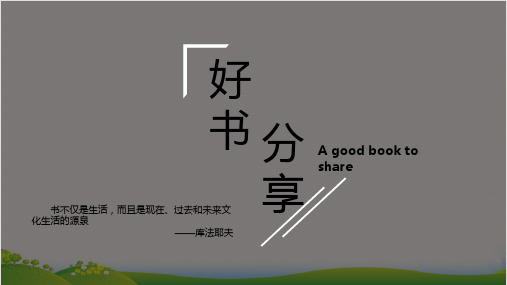
情节简介
汤姆知道后十分妒忌,在一次度假中与盖茨比激 烈争吵,黛西在心烦意乱下开车,碾死了汤姆的情妇。 盖茨比决定要帮黛西顶罪,却不知黛西已经打定主意 要抛弃盖茨比,汤姆将车祸嫁祸于盖茨比,致使盖茨 比被其情妇的丈夫枪杀。
情节简介
盖茨比信奉这盏绿灯,这个一年年在我 们眼前渐渐远去的极乐的未来。它从前 逃脱了我们的追求,不过那没关系—— 明天我们跑得更快一点,把胳臂伸得
更远一点……总有一天……
于是我们奋力向前划,逆流向上的 小舟,不停地倒退,进入过去。”
人物简介
人物简介
Tom Buchanan 汤姆
他曾经是一个体育明星,和 卡罗维先生是同学.婚后对黛 茜不好,并且还包养一个叫 做玛特尔·威尔逊的情妇。
作者简介
作者简介
弗朗西斯·斯科特·基·菲茨杰拉德
Francis Scott Key Fitzgerald
菲茨杰拉德才华横溢,在早年经历中 努力而巧妙的抹去的自己寒酸的出身, 参过军,两次恋爱经历都因家境贫寒 告吹,最终他靠自己的努力变成了一 个有钱人,妻子泽尔达才应允嫁给他, 两人原先十分恩爱,可是,日久天长, 两个人的性格不合,导致关系渐渐出 现裂缝。其中了不起的盖茨比是其生 活的另外一种讲述。最后他日日酗酒, 在圣诞节来临之际心脏病病发,终年 四十四岁。
当尼克在为盖茨比举行葬礼时,黛西正与汤姆前 往欧洲,之后再无音信。盖茨比最终彻底沦为牺牲品, 而他直到死也怀着对黛西的希望。
情节简介
然而,冰冷的现实容不下缥缈的梦,到 头来,盖茨比心中的女神只不过是凡尘俗世 的名利女郎。当一切真相大白,盖茨比的悲 剧人生亦如烟花般,在瞬间的璀璨之后成为 永恒的幻灭。
《了不起的盖茨比》文献基本信息

题目:《了不起的盖茨比》文献基本信息一、引言让我们切入正题,探讨一部备受推崇的文学作品,《了不起的盖茨比》。
这部小说是美国作家菲茨杰拉德(F. Scott Fitzgerald)于1925年出版的,被誉为20世纪最重要的小说之一。
其作品已被翻译成多种语言并成为世界文学史上的经典之作。
二、作者简介菲茨杰拉德(1896-1940)是美国20世纪最有才华的小说家之一,其还撰写了《美丽与丑陋》和《麦田守望者》两部小说。
他被誉为“爵士时代”的代表作家,刻画了20世纪20年代美国上流社会以及其道德沦丧的现象。
三、作品概况1.故事背景该小说背景设定在美国上流社会的黄金时代,即20世纪20年代,以长岛为背景,以百万富翁盖茨比的传奇爱情故事为主线。
2.故事主要内容故事主人公尼克卡拉韦是一个年轻的券商,因为不满纽约都市生活的虚伪,他搬到长岛的一栋房子居住,临湖而居。
作为自己的邻居,尼克认识了之后成为一生挚友的盖茨比。
尼克是观察者,了解了盖茨比在为重返往日的深爱之人黛西而不懈努力的也逐渐认清了盖茨比的梦想追逐让自己陷入绝望的危机之中。
故事中充满了爱情、梦想、欲望与追求,也充满着内心的挣扎与抉择。
3.主题意义《了不起的盖茨比》不仅是一部描写爱情的作品,在其深层中隐含着对美国梦的批判,对上流社会的无情嘲讽,对道德境况的探讨。
菲茨杰拉德在小说中巧妙地对美国社会进行了讽刺,表达了对美国梦的怀疑和对资本主义社会的不满。
四、文学价值1.叙述手法菲茨杰拉德以第一人称叙述的方式,将尼克卡拉韦镶嵌在整个故事中,以观察者的视角剖析、描绘出盖茨比一系列丰富多彩的人生遭遇。
2.语言艺术菲茨杰拉德用了大量的比喻、隐喻和象征手法,用风格优美的文字描绘出了一幅五味杂陈的社会画卷。
其文字幽默生动,写实而不乏诗意,给读者留下深刻的印象。
3.思想深邃《了不起的盖茨比》深刻地揭示了20世纪20年代美国上流社会的文化及其伦理沦丧的现象。
作品中所表现的人物性格与行为不仅具有时代特点,更具有普遍性的历史内涵,对人性与生活深刻的阐述使其具有永恒的价值。
菲茨杰拉德简介大学课

短篇小说风格独特,语言简练而 富有诗意,情节紧凑且引人入胜
。
长篇小说《夜色温柔》和《最后大亨》
《夜色温柔》
以主人公杰克的视角,展现了美国上层社会的虚伪和堕落,以及个人在追求真爱过程中的挣扎 和无奈。
《最后大亨》
讲述了一位电影大亨的人生经历,揭示了电影产业的黑幕和人性的贪婪。
诗歌和散文创作
菲茨杰拉德的作品对后世作家产生了深远的影响 ,他的写作风格和技巧被许多作家所借鉴和模仿 。
他的小说中对人物心理的细腻刻画、对情节的巧 妙安排以及对语言的精湛运用,都为后来的文学 创作提供了重要的启示。
跨时代意义:当代社会价值观思考
菲茨杰拉德的作品不仅具有文学价值,更具有跨时代的意义。他的小说中揭示的社会问题和人 性的困境,在当今社会依然存在。
研究方法、视角及创新点
01 研究方法
目前对菲茨杰拉德的研究主要采用文本分析、比 较研究、文化研究等方法。
02 视角
研究者们从文学、历史、文化、心理等多个视角 对菲茨杰拉德进行解读和研究。
03 创新点
近年来,一些研究者尝试运用新的理论和方法, 如后现代主义、女性主义等,对菲茨杰拉德进行 创新性研究,取得了不少成果。
1
菲茨杰拉德的诗歌风格独特,既有浪漫主义的激 情,又有现代主义的冷峻,表达了对生命、爱情 和死亡的深刻思考。
2
他的散文作品则以优美的文笔和深邃的思想著称 ,探讨了艺术、文化、社会等广泛主题。
3
无论是诗歌还是散文,菲茨杰拉德都以精湛的技 艺和敏锐的洞察力展现了其卓越的文学才华。
菲茨杰拉德在文学史上的地
主要人物
尼克·卡拉威(叙述者)、盖茨比(旧情人黛西的丈夫 )、黛西(盖茨比的旧情人,尼克的朋友)、汤姆·布 坎南(黛西的丈夫,富豪)、乔丹·贝克(尼克的朋友 ,职业高尔夫球手)。
F.-Scott-Fitzgerald-美国文学菲斯杰拉德

斯科特▪菲茨杰拉德
• Francis Scott Key Fitzgerald (September 24, 1896 – December 21, 1940), known professionally as F. Scott Fitzgerald, was an American novelist and short story writer, whose works illustrate the Jazz Age. While he achieved limited success in his lifetime, he is now widely regarded as one of the greatest American writers of the 20th century. Fitzgerald is considered a member of the "Lost Generation" of the 1920s. He finished four novels: This Side of Paradise, The Beautiful and Damned, The Great Gatsby, and Tender Is the Night. A fifth, unfinished novel, The Last Tycoon, was published posthumously. Fitzgerald also authored 4 collections of short stories, as well as 164 short stories in magazines during his lifetime.
Fitzgerald and the American Dream
美国文学之菲茨杰拉德福克纳海明威
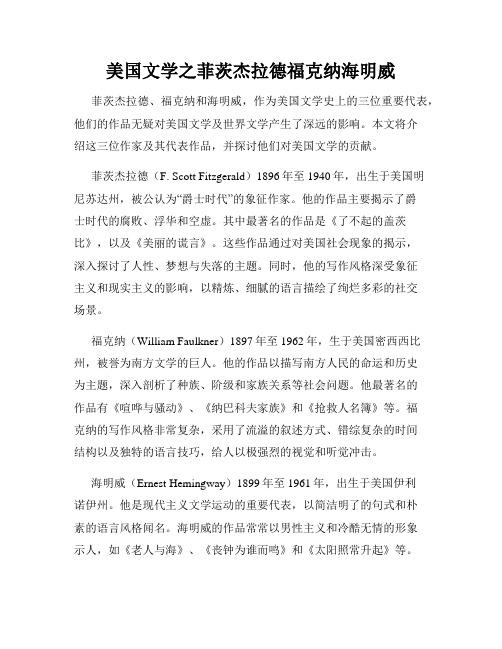
美国文学之菲茨杰拉德福克纳海明威菲茨杰拉德、福克纳和海明威,作为美国文学史上的三位重要代表,他们的作品无疑对美国文学及世界文学产生了深远的影响。
本文将介绍这三位作家及其代表作品,并探讨他们对美国文学的贡献。
菲茨杰拉德(F. Scott Fitzgerald)1896年至1940年,出生于美国明尼苏达州,被公认为“爵士时代”的象征作家。
他的作品主要揭示了爵士时代的腐败、浮华和空虚。
其中最著名的作品是《了不起的盖茨比》,以及《美丽的谎言》。
这些作品通过对美国社会现象的揭示,深入探讨了人性、梦想与失落的主题。
同时,他的写作风格深受象征主义和现实主义的影响,以精炼、细腻的语言描绘了绚烂多彩的社交场景。
福克纳(William Faulkner)1897年至1962年,生于美国密西西比州,被誉为南方文学的巨人。
他的作品以描写南方人民的命运和历史为主题,深入剖析了种族、阶级和家族关系等社会问题。
他最著名的作品有《喧哗与骚动》、《纳巴科夫家族》和《抢救人名簿》等。
福克纳的写作风格非常复杂,采用了流溢的叙述方式、错综复杂的时间结构以及独特的语言技巧,给人以极强烈的视觉和听觉冲击。
海明威(Ernest Hemingway)1899年至1961年,出生于美国伊利诺伊州。
他是现代主义文学运动的重要代表,以简洁明了的句式和朴素的语言风格闻名。
海明威的作品常常以男性主义和冷酷无情的形象示人,如《老人与海》、《丧钟为谁而鸣》和《太阳照常升起》等。
他通过对战争、人性和爱情等主题的探讨,以及对自然和人类关系的描绘,展现了他独特的写作风格和丰富的感情内涵。
这三位作家共同为美国文学作出了杰出的贡献。
菲茨杰拉德代表着爵士时代的荒谬与繁华,揭示了社会现象后面的人性和梦想的残酷。
福克纳则通过深入剖析南方人民的命运、家族和社会问题,展现了人类复杂的心灵世界。
海明威以朴素而犀利的笔触,以及战争和人性的主题,对现代主义文学运动产生了重大影响。
正是由于菲茨杰拉德、福克纳和海明威等作家的杰出贡献,美国文学得以获得一种独特的声音和地位。
弗朗西斯 斯科特基 菲茨杰拉德—外文翻译
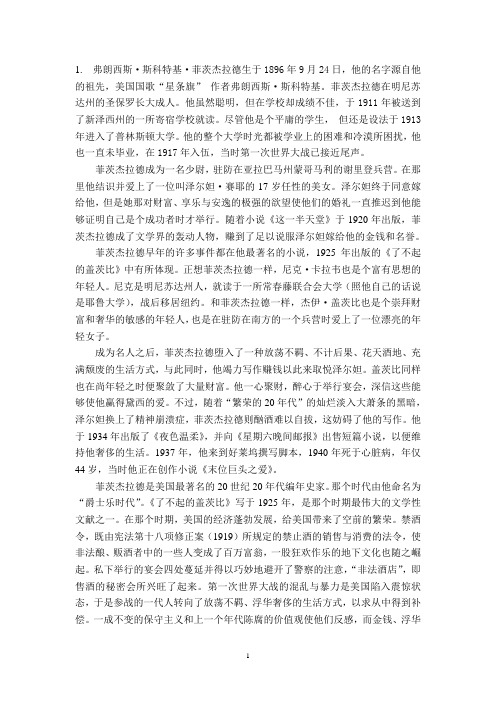
1. 弗朗西斯·斯科特基·菲茨杰拉德生于1896年9月24日,他的名字源自他的祖先,美国国歌“星条旗”作者弗朗西斯·斯科特基。
菲茨杰拉德在明尼苏达州的圣保罗长大成人。
他虽然聪明,但在学校却成绩不佳,于1911年被送到了新泽西州的一所寄宿学校就读。
尽管他是个平庸的学生,但还是设法于1913年进入了普林斯顿大学。
他的整个大学时光都被学业上的困难和冷漠所困扰,他也一直未毕业,在1917年入伍,当时第一次世界大战已接近尾声。
菲茨杰拉德成为一名少尉,驻防在亚拉巴马州蒙哥马利的谢里登兵营。
在那里他结识并爱上了一位叫泽尔妲·赛耶的17岁任性的美女。
泽尔妲终于同意嫁给他,但是她那对财富、享乐与安逸的极强的欲望使他们的婚礼一直推迟到他能够证明自己是个成功者时才举行。
随着小说《这一半天堂》于1920年出版,菲茨杰拉德成了文学界的轰动人物,赚到了足以说服泽尔妲嫁给他的金钱和名誉。
菲茨杰拉德早年的许多事件都在他最著名的小说,1925年出版的《了不起的盖茨比》中有所体现。
正想菲茨杰拉德一样,尼克·卡拉韦也是个富有思想的年轻人。
尼克是明尼苏达州人,就读于一所常春藤联合会大学(照他自己的话说是耶鲁大学),战后移居纽约。
和菲茨杰拉德一样,杰伊·盖茨比也是个崇拜财富和奢华的敏感的年轻人,也是在驻防在南方的一个兵营时爱上了一位漂亮的年轻女子。
成为名人之后,菲茨杰拉德堕入了一种放荡不羁、不计后果、花天酒地、充满颓废的生活方式,与此同时,他竭力写作赚钱以此来取悦泽尔妲。
盖茨比同样也在尚年轻之时便聚敛了大量财富。
他一心聚财,醉心于举行宴会,深信这些能够使他赢得黛西的爱。
不过,随着“繁荣的20年代”的灿烂淡入大萧条的黑暗,泽尔妲换上了精神崩溃症,菲茨杰拉德则酗酒难以自拔,这妨碍了他的写作。
他于1934年出版了《夜色温柔》,并向《星期六晚间邮报》出售短篇小说,以便维持他奢侈的生活。
菲茨杰拉德简介(2024)

菲茨杰拉德出生于一个中产阶 级家庭,从小受到良好的教育 。
2024/1/29
他与旧情人旧梦重温的关系是 他作品中常见的主题,这可能 与他的个人感情经历有关。
他的婚姻生活经历了起伏,与 妻子泽尔达的关系时好时坏, 这对他的创作产生了深远的影 响。
24
与好友关系及互动
菲茨杰拉德与海明威等作家是好 友,他们经常在一起交流文学观
16
对后世作家的影响
2024/1/29
对海明威的影响
海明威是菲茨杰拉德的好友,两人在文学创作上相互影响。菲茨杰拉德的作品对海明威的 创作风格产生了重要影响,尤其是在叙事技巧和人物塑造方面。
对塞林格的影响
塞林格是20世纪美国著名的小说家,他的作品《麦田里的守望者》等受到了菲茨杰拉德 的深刻影响,尤其是在揭示青少年内心世界和成长主题方面。
念。
他与一些艺术家和知识分子也有 深厚的友谊,这些友谊对他的世
界观和文学观念产生了影响。
他的社交圈很广,经常出入各种 社交场合,这也为他的创作提供
了丰富的素材。
2024/1/29
25
有趣的轶事和传闻
据说菲茨杰拉德在创作《了不起的盖茨比》时,曾经因为过度饮酒而耽误了写作进 度。
有传闻称,他的小说《夜色温柔》中的某些情节受到了他与旧情人关系的启发。
5
所处时代背景及影响
2024/1/29
菲茨杰拉德创作的高峰期,正是美国历史上一个特殊的时代 ——“爵士时代”。第一次世界大战结束了(1918),经济大 萧条(1929)还没有到来,传统的清教徒道德已经土崩瓦解, 享乐主义开始大行其道。
用菲茨杰拉德自己的话来说,“这是一个奇迹的时代,一个 艺术的时代,一个挥金如土的时代,也是一个充满嘲讽的时 代。”菲茨杰拉德称这个时代为“爵士时代”,并以此为名 写下了他的第一部短篇小说集。
弗.司各特.菲茨杰拉德F.ScottFitzgerald,作者简介和作品目录列表...

弗.司各特.菲茨杰拉德F.ScottFitzgerald,作者简介和作品目录
列表...
作者简介
菲兹杰拉德,F. Scott Fitzgerald,1896 -- 1940,美国小说家。
1896年9月24日菲兹杰拉德生于明尼苏达州圣保罗市。
父亲是家具商。
他年轻时试写过剧本。
读完高中后考入普林斯顿大学。
在校时曾自组剧团,并为校内文学刊物写稿。
后因身体欠佳,中途辍学。
1917年菲兹杰拉德入伍,终日忙于军训,未曾出国打仗。
退伍后坚持业余写作。
1920年菲兹杰拉德出版了长篇小说《人间天堂》,从此出了名,小说出版后他与吉姗尔达结婚。
婚后携妻寄居巴黎,结识了安德逊、海明威等多位美国作家。
1925年《了不起的盖茨比》问世,奠定了他在现代美国文学史上的地位,成了20年代“爵士时代”的发言人和“迷惘的一代”的代表作家之一。
菲兹杰拉德成名后继续勤奋笔耕,但婚后妻子讲究排场,后来又精神失常,挥霍无度,给他带来极大痛苦。
他经济上入不敷出,一度去好莱坞写剧本挣钱维持生计。
1936年不幸染上肺病,妻子又一病不起,使他几乎无法创作,精神濒于崩溃,终日酗酒。
1940年12月21日菲兹杰拉德迸发心脏病,死于洛杉矶,年仅44岁。
菲兹杰拉德不仅写长篇小说,矩篇小说也频有特色。
除上述两部作品外,主要作品还有《夜色温柔》(1934)和《最后一个巨商》(1941)。
他的小说生动地反映了20年代“美国梦”的破灭,展示了大萧条时朗美国上层社会“荒原时代”的精神面貌。
【名著选读】菲茨杰拉德《最后一个南方女郎》

【名著选读】菲茨杰拉德《最后一个南方女郎》《最后一个南方女郎》是美国著名作家菲茨杰拉德一篇关于几个军人和一个南方女郎爱情纠葛的短篇小说。
讲述了南方少女和北方青年的爱情故事,并对南方与北方在文化上和社会上的差异进行了探讨。
南方是一个炎热、柔软、慵懒、令人微微欲醉的地方,那里有“开满鲜花的炎热黄昏”和“令人回味的木兰花香”。
弗-斯-菲茨杰拉德(1896~1940),美国小说家。
生于美国明尼苏达州保罗市一个商人家庭。
1917年于普林顿大学辍学入伍,1919年退伍。
次年发表长篇小说《人间天堂》,一举成名,遂与姗尔达-赛瑞成婚,她对他的生活和创作都产生较大的影响。
他的创作倾向具有“迷惘的一代”的特征。
1925年其代表作《伟大的盖茨比》出版,以对美国理想的破灭揭示了他的双重性格和内心冲突,被誉为当代最深刻的一部美国小说,从而确立了他在美国文学史上的地位,使其成为20世纪美国文学史上最重要的作家之一。
此后,他的重要作品还有长篇小说《夜色温柔》和《最后一个巨头》。
《最后一个南方女郎》是一篇关于几个军人和一个南方女郎爱情纠葛的短篇小说。
1经受了亚特兰大①那富有戏剧性的、十足南方风味的魅力后,我们大家都认为塔莱顿真是个鬼地方,因为那儿比我们到过的任何地方都热——第一天就有十几个新兵倒在佐治亚州火辣辣的太阳底下。
要是你看到牛群被黑人“唏……呀”地吆喝着慢慢赶过商业街,你就会觉得在炎热的大白天也会恍恍惚惚——人们多么想动一动手或动一动脚,以便知道自己还活着。
我留在外面的营房里,听沃伦少尉讲那些姑娘们的事情。
那是15年以前的事了,我忘了我当时是什么感觉,我只知道光阴一天一天地逝去,日子比今天好过,我的心里是空空的,因为她在北方举行了婚礼,她的光彩在我心里留驻了3年。
我看了报纸上的报道和照片,那是“一次带着火药味的浪漫主义婚礼”。
一切是那样豪华,然而又显得那样凄然,我清楚地记得天空在昏暗中闪光,婚礼就是在这样的气氛中举行的。
F.Scott Fitzgerald
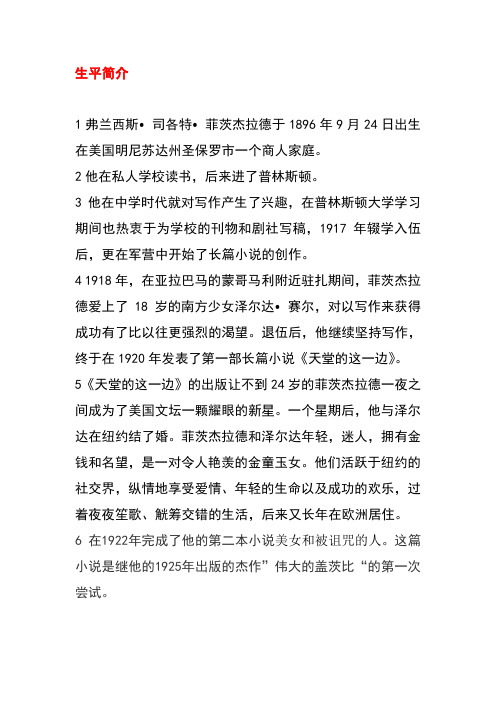
生平简介1弗兰西斯•司各特•菲茨杰拉德于1896年9月24日出生在美国明尼苏达州圣保罗市一个商人家庭。
2他在私人学校读书,后来进了普林斯顿。
3他在中学时代就对写作产生了兴趣,在普林斯顿大学学习期间也热衷于为学校的刊物和剧社写稿,1917年辍学入伍后,更在军营中开始了长篇小说的创作。
4 1918年,在亚拉巴马的蒙哥马利附近驻扎期间,菲茨杰拉德爱上了18岁的南方少女泽尔达•赛尔,对以写作来获得成功有了比以往更强烈的渴望。
退伍后,他继续坚持写作,终于在1920年发表了第一部长篇小说《天堂的这一边》。
5《天堂的这一边》的出版让不到24岁的菲茨杰拉德一夜之间成为了美国文坛一颗耀眼的新星。
一个星期后,他与泽尔达在纽约结了婚。
菲茨杰拉德和泽尔达年轻,迷人,拥有金钱和名望,是一对令人艳羡的金童玉女。
他们活跃于纽约的社交界,纵情地享受爱情、年轻的生命以及成功的欢乐,过着夜夜笙歌、觥筹交错的生活,后来又长年在欧洲居住。
6 在1922年完成了他的第二本小说美女和被诅咒的人。
这篇小说是继他的1925年出版的杰作”伟大的盖茨比“的第一次尝试。
7但由于讲究排场,挥霍无度,他们的生活渐渐捉襟见肘。
泽尔达因精神病多次发作被送进精神病院,菲茨杰拉德也染上了酗酒的恶习。
1940年12月21日,菲茨杰拉德因为心脏病突发死于洛杉矶,年仅44岁。
8弗兰西斯•司各特•菲茨杰拉德死后留下他最后一部长篇小说最后的大亨未完成的。
笔记小说编辑,由他的朋友埃德蒙·威尔逊帮他完成并出版于1941年。
这本小说认为他最成熟的小说。
1Francis, Scott Fitzgerald was born on September 26,1896 in St. Paul Minnesota,.2He first in private schools,and then at Princeton.3He began to write for the club.,become editor of a university magazine. In 1917 he drop out and to enlist in the US Army.4 In 1918, Fitzgerald fell in love with Zelda. The daughter of an Alabama Supreme Court Judge,a beautiful, light-hearted girl. Francis, Scott Fitzgerald has the strong desire for more than ever. After retiring from army, he continued to insist on writing, finally , the first novel "This side of paradise" was published in 1920.5,"This side of paradise "make Francis, Scott Fitzgerald became an overnight of the literary a shining star. After a week, he got married with Zelde in New York . Fitzgerald andZeldeo lived a luxurious life. They need for money was voracious. They active in New York society, to enjoy the love, indulge in the lives of young and the joy of success, and later living in Europe.6 In 1922 Francis, Scott Fitzgerald finished his second novel,"The Beautiful and Damned“.This novel is a sore of first attempt at writing his masterpiece The Grert Gatsby,which was published in 1925.7In the 1930s ,Francis, Scott Fitzgerald reputation declined, his wealth fell,his health failed and Zelda suffered from mental illness. Fitzgerald also caught drinking habits and alcoholism. He died of a heart attack On December 21, 1940. just 44 years old.8Francis, Scott Fitzgerald died leaving his last novel The Last Tycoon unfinished .His notes for the novel were edited by his friend Edmund Wilson and published in 1941 as The Last Tycoon. This novel consider as the most mature of his novels.剧本:Beautiful and Damned《美女和被诅咒的人》The Great Gatsby 《伟大的盖茨比》Tender is the night 《夜色温柔》长篇小说:The Last Tycoon《最后一个大亨》T his side of paradise《天堂的这一边》短片小说:Flappers and Philosopher(1920)《姑娘们与哲学家们》Tales of the Jazz Age (1922)《爵土时代的故事》All the Sad Young Men (1926)《所有悲伤的年轻人》Taps at Reveille(1935)《水龙头起床号》。
《菲兹杰拉德》课件

追求美国梦,即通过个人努力和 奋斗实现财富和社会地位的提升
。
梦想与现实的冲突
盖茨比的梦想与现实社会存在着巨 大的鸿沟,这导致了他的悲剧结局 。
对现实的反思
盖茨比的悲剧引发了对当时美国社 会现实的深刻反思,人们开始认识 到美国梦的虚幻性和局限性。
盖茨比的人生哲学和价值观
01
02
03
04
个人奋斗
象征意义
绿色灯塔象征着盖茨比的梦想和追求 ;黛茜家的码头象征着盖茨比与黛茜 的过去和无法实现的爱情。
CHAPTER 03
《了不起的盖茨比》的艺术 特色
语言风格和技巧
语言优美
菲茨杰拉德的语言运用得非常优美, 他的文字表达富有诗意,给人留下深 刻的印象。
比喻和象征
细节描写
菲茨杰拉德非常注重细节描写,他通 过对人物、场景、物品等细节的刻画 ,让读者更加深入地理解人物和故事 。
人物塑造和描写
人物性格
菲茨杰拉德的人物塑造非常成功,他通过对人物性格的深入挖掘和刻画,使得人 物形象更加鲜明和立体。
人物关系
菲茨杰拉德非常注重人物之间的关系,他通过人物之间的互动和关系,来推动故 事的发展和深化主题。
CHAPTER 04
《了不起的盖茨比》的社会 意义
20世纪20年代美国社会背景
经济繁荣
20世纪20年代,美国经济 经历了一个飞速发展的时 期,被称为“爵士时代” 。
消费主义盛行
随着经济的繁荣,消费主 义文化逐渐成为主流,人 们对物质享受的追求达到 了前所未有的高度。
道德观念转变
这个时代的年轻人对传统 的道德观念和价值观产生 了质疑,开始追求自由、 享乐和个人主义。
盖茨比的梦想与现实
2024版美国文学菲茨杰拉德Fitzgerald课件

2024/1/29
1
目录
• 菲茨杰拉德简介与背景 • 《了不起的盖茨比》解读 • 《夜色温柔》赏析 • 菲茨杰拉德短篇小说选讲 • 菲茨杰拉德创作风格与技巧 • 菲茨杰拉德与其他作家比较研究
2024/1/29
2
01
菲茨杰拉德简介与背景
2024/1/29
2024/1/29
5
文学地位及影响
文学地位
菲茨杰拉德被誉为20世纪美国文学的重要代表之一,他的作品以独特的风格和深刻的社会洞察力赢得了 广泛的赞誉。他的小说作品不仅在当时引起了轰动,而且对后来的文学创作产生了深远的影响。
影响
菲茨杰拉德的作品对后来的文学创作产生了重要的影响,尤其是在描绘人物性格和揭示社会问题方面。他 的作品启发了许多作家和艺术家,成为他们创作的灵感源泉。同时,他的作品也深刻地反映了人类精神世 界的复杂性和多样性,对读者产生了深远的影响。
小说通过讲述主人公盖茨比的人生经历以及他与 旧情人黛茜的关系,揭示了美国上层社会的虚伪 和冷酷。
《夜色温柔》
小说以主人公迪克的视角,展现了20世纪20年 代美国社会的风貌和人们的精神状态。
3
《人间天堂》 小说讲述了主人公艾默生的成长历程和他在追求 自我认同的过程中所经历的挫折和迷茫。
2024/1/29
与斯坦贝克比较
两者都关注社会底层人民的苦难和斗争,但菲茨杰拉德更注重对人性的揭示和批判,而斯坦 贝克则更强调社会的不公和改革。
26
THANKS
感谢观看
2024/1/29
27
2024/1/29
6
02
《了不起的盖茨比》解读
2024/1/29
作为浪漫主义批评家的菲茨杰拉德

2012.11学教育17作为浪漫主义批评家的菲茨杰拉德牛慧静(广西师范学院文学院,广西南宁530023)[摘要]弗朗西斯·司各特·菲茨杰拉德(F.Sc ot t Fi t z ger a l d,1896~1940)是美国二十世纪二十年代杰出的文学艺术家,著名经典作家之一。
在文学界和具有较高审美的严肃读者群中,被认为是“爵士乐时代”的桂冠诗人、“流亡海外文艺集团”里的杰出代表。
其作品有着深厚的浪漫主义哲学渊源,他不仅仅是一名杰出的小说家,同时也是一名活跃的批评家。
[关键词]浪漫主义;现实主义;批评;济慈;华兹华斯一、活跃的批评家作为美国爵士乐时代最有影响力的作家之一,菲茨杰拉德深受济慈、华兹华斯等经典浪漫主义作家的影响,其作品有着深厚的浪漫主义哲学渊源。
但菲茨杰拉德并不仅仅是一名杰出的小说家,同时也是一名活跃的批评家。
他把丰富的浪漫主义理论淋漓尽致地运用于批评和小说创作中,他出版的许多作品都表达了自己富有创造性的浪漫主义理论观点,美国著名的菲茨杰拉德研究学者罗纳德·伯曼(Berman,Ronald )称之为“最后一位浪漫的批评家”。
①菲茨杰拉德对于语言的观点有着很多思考和期待,他主张对浪漫主义观点的论证和更新,不仅仅希望人们提及他的时候,总会片面地认为他是一个浪漫的人,一个拥有与盖茨比(Jay Gatsby )一样的性格特点、处境和命运的人。
他运用柯勒律治(Coleridge )、济慈(Keats )和华兹华斯(Wordsworth )的学说,接受生命的稍纵即逝的暂时性观点。
想要理解这种暂时性,就需要依赖于文学提供的某种意义,但对于这种意义的表达却是艰难的,而且为了明确这种意义,就需要理解一定形式的经验:以时间的无情流逝,生命本身被迫消逝定义其本身的意义;对重复经验的普遍渴望;对主观立场的巨大坚定。
尽管菲茨杰拉德经常在其批评创作中使用“浪漫”这个词,但却很少将其运用到对情感、感知或情绪的表达中,这体现了他对所描绘细节的精细程度的超强感知力,他的作品措辞精炼,试图重新挖掘我们所熟知的事物中的重大意义。
菲茨杰拉德

谢谢 thank you
菲茨杰拉德 与 《了不起的盖茨比》
主讲:周颖
组员:刘莉红、马琳、古晓霞、穆云云、邹玉霞、 郑源、凌鸽、郭家萌、聂锋、许旻昱
一、目录
• • • • • 1、写作背景及作者简介 2、人物形象特点分析 3、象征手法分析 4、作品主题分析 5、作品影响及文学史意义分析
一、作家简介
弗朗西斯· 斯科特· 基· 菲茨 杰拉德(Francis Scott Key Fitzgerald ) 美国小说家, 是“迷惘的一代”(Lost Generation)的代表作家, 也是“爵士乐时代”(Jazz Age)的桂冠诗人。
• 主题三:物质主义和理想主义之间的碰撞与对立
• 主题四:尼克的斗
四、作品的文学史意义
• 1.被誉为当代最出色的美国小说之一
• 2.他创造出的若干用语和表达方法成为人们模仿
和研究的对象
• 3.主人公既是冷静的叙述者又是情节的参与者,
丰富作品层次,成为作者艺术上的独特成就
( 1896-1940)
• 二、人物形象 • 盖茨比
1、爱慕虚荣 2、扭曲的爱情观
• 黛西
1、外表美丽可爱,内心 虚伪浅俗 2、物质至上、拜金虚荣 3、冷漠无情 4、男权制社会下的牺牲 品:隐忍与妥协
三、主题分析
主题一:盖茨比“美国梦”的追求和幻灭
• 主题二:揭示二十世纪初美国社会道德的堕落
2024菲茨杰拉德简介

菲茨杰拉德简介•菲茨杰拉德生平•主要作品介绍•文学地位与影响•时代背景与思潮关联•艺术特色与创作技巧探讨•个人生活轶事趣闻分享目录CONTENTS01菲茨杰拉德生平1913年进入普林斯顿大学学习,原本希望成为一名律师或作家,但最终因为成绩不佳和身体原因未能如愿。
在大学期间开始尝试写作,并结识了许多文学爱好者,这对他的文学创作产生了重要影响。
出生于明尼苏达州圣保罗市的一个中产阶级家庭,其父是家具商。
早年经历与教育背景文学创作历程及成就1920年发表了第一部长篇小说《人间天堂》,一举成名,成为“爵士时代”的代言人和“迷惘的一代”的重要作家之一。
随后的作品包括《美丽与毁灭》、《大亨小传》等,都取得了不俗的文学成就和商业成功。
他的作品以描绘20世纪20年代的美国社会风貌和年轻人的精神困境而著称,被誉为美国现代主义文学的重要代表之一。
家庭生活与社交圈子1920年与泽尔达·赛瑞结婚,夫妻二人都是当时社交圈子的名流,生活奢华而充满活力。
然而,婚姻生活并非一帆风顺,夫妻二人都有酗酒的习惯,这在一定程度上影响了他们的文学创作和家庭生活。
菲茨杰拉德在社交场合中结识了许多文学界、艺术界和电影界的名人,这些交往对他的创作和生活都产生了影响。
尽管晚年的境遇不佳,但菲茨杰拉德留下的文学遗产仍然熠熠生辉,他的作品至今仍然被广泛阅读和研究,对后来的作家和文学流派产生了深远的影响。
晚年时期,菲茨杰拉德的健康状况每况愈下,同时文学创作也陷入了困境,生活陷入潦倒。
1940年12月21日,菲茨杰拉德因心脏病突发去世,年仅44岁。
晚年境遇及遗产02主要作品介绍《人间天堂》内容概述与主题思想内容概述《人间天堂》是菲茨杰拉德的首部长篇小说,讲述了一群年轻人在“爵士时代”背景下的生活经历,反映了当时美国社会的风貌和年轻人的迷茫与追求。
主题思想小说通过主人公艾莫里·布莱恩的成长经历,揭示了美国梦背后的虚幻与破灭,以及年轻人在追求自我认同和价值的过程中所面临的困境和挣扎。
著名作家菲茨杰拉德简介
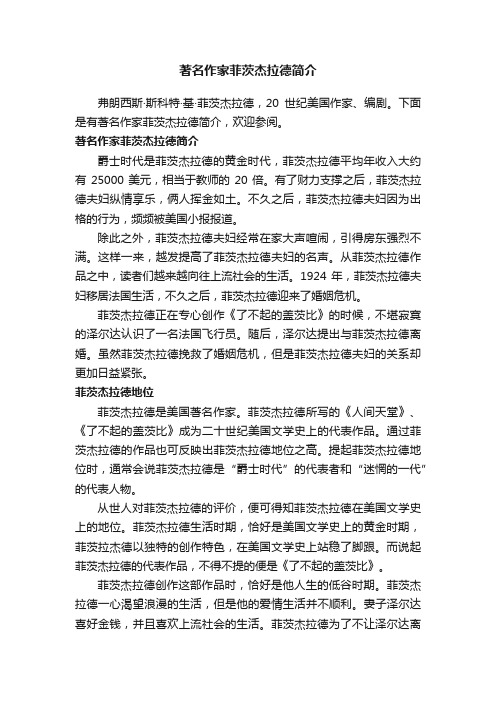
著名作家菲茨杰拉德简介弗朗西斯·斯科特·基·菲茨杰拉德,20世纪美国作家、编剧。
下面是有著名作家菲茨杰拉德简介,欢迎参阅。
著名作家菲茨杰拉德简介爵士时代是菲茨杰拉德的黄金时代,菲茨杰拉德平均年收入大约有25000美元,相当于教师的20倍。
有了财力支撑之后,菲茨杰拉德夫妇纵情享乐,俩人挥金如土。
不久之后,菲茨杰拉德夫妇因为出格的行为,频频被美国小报报道。
除此之外,菲茨杰拉德夫妇经常在家大声喧闹,引得房东强烈不满。
这样一来,越发提高了菲茨杰拉德夫妇的名声。
从菲茨杰拉德作品之中,读者们越来越向往上流社会的生活。
1924年,菲茨杰拉德夫妇移居法国生活,不久之后,菲茨杰拉德迎来了婚姻危机。
菲茨杰拉德正在专心创作《了不起的盖茨比》的时候,不堪寂寞的泽尔达认识了一名法国飞行员。
随后,泽尔达提出与菲茨杰拉德离婚。
虽然菲茨杰拉德挽救了婚姻危机,但是菲茨杰拉德夫妇的关系却更加日益紧张。
菲茨杰拉德地位菲茨杰拉德是美国著名作家。
菲茨杰拉德所写的《人间天堂》、《了不起的盖茨比》成为二十世纪美国文学史上的代表作品。
通过菲茨杰拉德的作品也可反映出菲茨杰拉德地位之高。
提起菲茨杰拉德地位时,通常会说菲茨杰拉德是“爵士时代”的代表者和“迷惘的一代”的代表人物。
从世人对菲茨杰拉德的评价,便可得知菲茨杰拉德在美国文学史上的地位。
菲茨杰拉德生活时期,恰好是美国文学史上的黄金时期,菲茨拉杰德以独特的创作特色,在美国文学史上站稳了脚跟。
而说起菲茨杰拉德的代表作品,不得不提的便是《了不起的盖茨比》。
菲茨杰拉德创作这部作品时,恰好是他人生的低谷时期。
菲茨杰拉德一心渴望浪漫的生活,但是他的爱情生活并不顺利。
妻子泽尔达喜好金钱,并且喜欢上流社会的生活。
菲茨杰拉德为了不让泽尔达离开他,他便疯狂地赚钱养家。
在与泽尔达的婚姻生活中,菲茨杰拉德看清楚了金钱社会的本质。
所以,菲茨杰拉德创作了《了不起的盖茨比》,他以美国上流社会为基点,慢慢地揭露出社会残酷的本质。
菲茨杰拉德简介英文
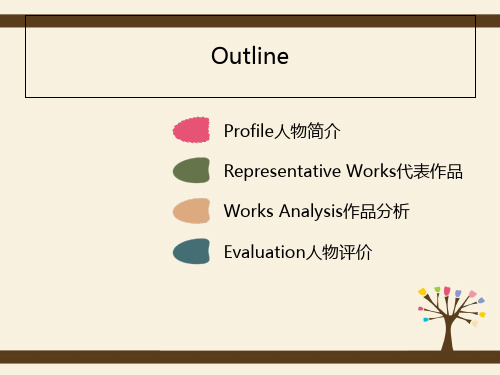
Conclusion
• reveals the falseness of ideals and moves toward disillusion
• All his stories:morality, industry, and maturity(成熟)
• his stories can be regarded as moral fables. He was interested in people’s dreams and failures. He showed more interest in subject matter than in structure.
Thank You!
• Gatsby:the embodiment of this dream
• a poor farm boy——a rich businessman
• Gatsby is never truly one of the elite;his dream is just a fantasy.
Fitzgerald’s Fiction
full-length novel(长篇小说) 《Tender Is the Night》1934
Works Analysis作品分析 the broken American dream
The American Dream
hard work,courage,determination achieve financial and personal success an emphasis on material wealth as a measure of success and happiness
• writing style:simple, vivid, graceful, preci• one of the greatest American writers of the 20th century
- 1、下载文档前请自行甄别文档内容的完整性,平台不提供额外的编辑、内容补充、找答案等附加服务。
- 2、"仅部分预览"的文档,不可在线预览部分如存在完整性等问题,可反馈申请退款(可完整预览的文档不适用该条件!)。
- 3、如文档侵犯您的权益,请联系客服反馈,我们会尽快为您处理(人工客服工作时间:9:00-18:30)。
Works of F. Scott Fitzgerald ■ 5 Notes ■ 6 References ■ 7 Further reading ■ 8 External links
Scott spent the first decade of his childhood primarily in Buffalo, New York (1898–1901 and 1903– 1908, with a short interlude in Syracuse, New York between January 1901 and Sept both practicing Catholics, sent Scott to two Catholic schools on the West Side of Buffalo, first Holy Angels Convent (1903–1904, now disused) and then Nardin Academy (1905–1908). His formative years in Buffalo revealed him to be a boy of unusual intelligence and drive with a keen early interest in literature, his doting mother ensuring that her son had all the advantages of an upper-middle-class upbringing.[7] In a rather unconventional style of parenting, Scott attended Holy Angels with the peculiar arrangement that he go for only half a day—and was allowed to choose which half.[6]
When Scott was ten years old, his father was fired from Procter & Gamble, and the family returned to Minnesota, where Fitzgerald attended St. Paul Academy in St. Paul from 1908–1911. His first literary effort, a detective story, was published in a school newspaper when he was 13. When he was 16, he was expelled from St. Paul Academy for neglecting his studies. He attended Newman School, a prep school in Hackensack, New Jersey, in 1911–1912, and entered Princeton University in 1913 as a member of the Class of 1917. There he became friends with future critics and writers Edmund Wilson (Class of 1916) and John Peale Bishop (Class of 1917), and wrote for the Princeton Triangle Club and the Princeton Tiger. His absorption in the Triangle—a kind of musical-comedy society—led to his submission of a novel to Charles Scribner's Sons where the editor praised the writing but ultimately rejected the book. He was a member of the University Cottage Club, which still displays Fitzgerald's desk and writing materials in its library. A poor student, Fitzgerald left Princeton to enlist in the US Army during World War I; however, the war ended shortly after Fitzgerald's enlistment.[8]
■ 1 Life and career ■ 1.1 Zelda Fitzgerald ■ 1.2 "The Jazz Age" ■ 1.3 Hollywood years ■ 1.4 Illness and death
■ 2 Legacy ■ 3 Portrayals ■ 4 Bibliography
Died
December 21, 1940 (aged 44) Hollywood, Los Angeles, California, United States
Occupation novelist, short story writer, poet
Nationality Period
American 1920–40
Genres
Modernism
Literary movement
Lost Generation
Signature
/wiki/F._Scott_Fitzgerald
2012-4-13
F. Scott Fitzgerald - Wikipedia, the free encyclopedia
Novels such as The Great Gatsby and Tender is the Night were made into films, and in 1958 his life from 1937–1940 was dramatized in Beloved Infidel.
Contents
Page 2 of 11
Life and career
Born in 1896 in Saint Paul, Minnesota to an upper middle class Irish Catholic family, Fitzgerald was named after his famous second cousin, three times removed, Francis Scott Key,[2] but was referred to as "Scott." He was also named after his deceased sister, Louise Scott,[3] one of two sisters who died shortly before his birth. "Well, three months before I was born," he wrote as an adult, "my mother lost her other two children....I think I started then to be a writer."[4]. His parents were Mollie (McQuillan) and Edward Fitzgerald.[5]
Zelda Fitzgerald
Main article: Zelda Fitzgerald
While at a country club, Fitzgerald met Zelda Sayre (1900–1948), the "golden girl," in Fitzgerald's terms, of Montgomery, Alabama youth society. Fitzgerald attempted to lay a foundation for his life with Zelda. Despite working at an advertising firm and writing short stories, he was unable to convince Zelda that he would be able to support her, leading her to break off the engagement. Scott returned to his parents' house at 599 Summit Avenue, on Cathedral Hill, in St. Paul, to revise The Romantic Egoist. Recast as This Side of Paradise, about the post-WWI flapper generation, it was accepted by Scribner's in the fall of 1919, and Zelda and Scott resumed their engagement. The novel was published on March 26, 1920, and became one of the most popular books of the year. Scott and Zelda were married in New York's St. Patrick's Cathedral. Their only child, Frances Scott "Scottie" Fitzgerald, was born on October 26, 1921 and died on June 16, 1986.
